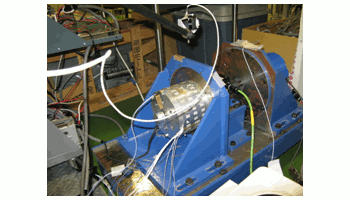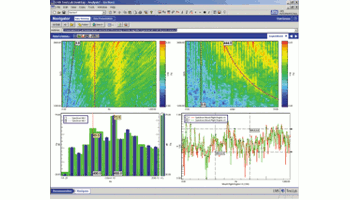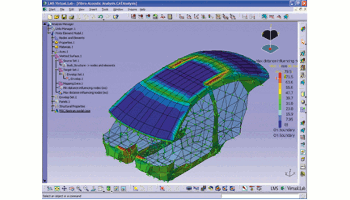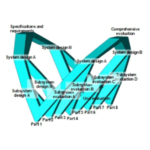How far has model based development spread? CAE edition
I laid out the logic behind model based development in the series that I wrote last year, so this year I would like to report on how it is actually being used in the field. I plan on interviewing vendors who work alongside JMAG to support model based development in order to clarify what engineers in control and mechanism development think about this development method, and what they expect from us, the electrical engineers. These interviews should give me and my coworkers a chance to learn what steps to take moving forward.
Last year, we at JSOL began running vibration noise analyses on permanent magnet motors with Shibaura Institute of Technology and LMS Japan. We gave a progress report during a seminar at the JMAG Users Conference last year, and I was surprised at how many people came to attend. It made me realize that there are a great many people concerned about these problems. In this issue, we hear from Mr. Asano and Mr. Ito of LMS Japan, one of our co-researchers. They talk about various themes, including how professional vibration and sound control engineers look at model based development application in electrical equipment.
The Importance of Reducing Noise Vibration
The story behind the increasing importance of noise vibration reduction
NV (noise vibration) is becoming more and more important as a development challenge for electrical equipment, because miniaturization and higher density in equipment have made it easier for motors and actuators themselves to vibrate. This problem is compounded by the fact that sound insulation can only be used to a limited degree, making NV impossible to ignore. At the same time, sound reduction requirements have been getting stricter because equipment is being used in quiet environments like rooms. This is why engineers who design electrical equipment like motors now have to meet NV requirements, in addition to fulfilling traditional basic characteristics like output and efficiency. However, those in the electrical equipment world are not the only ones who demand NV reduction, as it has almost gotten to the point where no appliance can be allowed to have noise vibration anymore.
In this issue, we asked engineers from LMS Japan, who are specialists in measuring and analyzing NV, what kinds of approaches NV engineers take toward solving problems with noise and vibration. Their responses should provide a good reference for how to proceed with solutions to NV problems, which electrical equipment engineers will most likely have to start dealing with in the next few years.
LMS Japan K.K.
Pre-sales Simulation 3D Supervisors
Shunji Asano
Hiroto Ito
The Difficulty of Noise Vibration Simulation Vibration analysis focuses on resonance
The story behind the increasing importance of noise vibration reduction
JSOL I understand resonance and damping in electric circuits, but I’ve never really had the chance to properly think about physical vibration and noise even though they occur in everyday life, so I can’t really get a picture of how they occur or how to solve them. Tell us about which parts of a noise vibration simulation can be difficult.
LMS Simulating NV is different from (structural) static analysis, which evaluates physical quantities like stress, deformation, and distortion. A dynamic analysis that handles vibration and noise needs to simultaneously evaluate several indicators that change with evaluation location, frequency, and time. This is why we need a unique approach toward countermeasures and design changes. A static analysis uses quantity size as its guideline, but the distinction with a dynamic analysis is that it focuses on resonance.
We need an analysis approach that lets us get to the root of the phenomenon without getting confused about changes in superficial indicators. We need to be able to clarify which things are predominant and which things we, the engineers, can control. In order to proceed accurately and efficiently with an analysis, correct knowledge and experience are necessary when it comes to finding a way to capture invisible boundary conditions and load conditions in a mathematical model.
JSOL What difficulties do you face in measuring vibration?
LMS In experimental analysis, one needs to innovate ways of bringing out the essential quantities instead of just measuring the phenomenon as it is. Complete noise removal, thinking of ways to measure places where you can’t attach sensors, processing waveform signals based on correct knowledge… All of these require expertise supported by experience and knowledge gained in the field.
We need both the theoretical and experimental sides to obtain universal solutions and knowledge from a measurement model (Figures 1 and 2).
 Fig. 1 Real operation NV test of Harumi Model 1
Fig. 1 Real operation NV test of Harumi Model 1
 Fig. 2 LMSTest.Lab screenshot
Fig. 2 LMSTest.Lab screenshot
Forecasting vibration
JSOL Motor designers who have accumulated a certain amount of experience can look at a magnetic circuit, picture the magnetic flux flow, and judge the design’s good and bad points. Can a vibration engineer look at a structure and tell which parts will probably produce vibration and noise? Is it the kind of thing where you can tap a piece of equipment like a doctor palpitates a patient’s chest and determine where noise will be produced?
LMS There are times when, if I have the real piece of equipment, I can get a sense of its weight (by holding it) and its rigidity (by listening to the sound it makes when I tap it) and tell what the check points of its model would be. Someone with a lot of experience can probably judge the dominant frequency range and mode shape, too. This ability to sense things is also important for a person creating simulation models.
Focusing on natural frequencies and mode shapes
JSOL Which places in measurement and analysis values do NV engineers pay attention to?
LMS Basically, the thing that becomes a problem with noise and vibration is resonance. The key to eliminating harmful vibration is avoiding resonance. Vibration is determined by the excitation force generated in the structure and how easy it is for the parts themselves to vibrate, so when it comes to the structure we have to give careful thought to both its resonant frequency and its mode shape, and check how they are vibrating.
On the other hand, though, we don’t really focus on the amplitude of the vibration. Mathematically speaking, in the neighborhood of resonant frequency even a deviation of 1 Hz can change the resonance response level several dozen or even several hundred fold. Modal damping also contributes to the amplitude, but it cannot adhere too much to the vibration because the damping itself is not the root of the vibration.
What it all boils down to is the fact that vibration is an exchange of energy that follows an equation of motion between rigidity and inertia. This makes it vital to obtain the natural frequency and mode shape, which are vibration modes of the structure, regardless of whether one is dealing with an experiment or a simulation. These are what the designer takes countermeasures against.
LMS and NV Solutions
The history of LMS
JSOL Give us a brief introduction to LMS.
LMS We were established in Leuven, Belgium, in 1979. We started developing and selling experiment measurement and data analysis systems aimed at experimental system engineering related to noise and vibration phenomena. We are currently providing total solutions, including the development and sales of simulation tools, that cover experimental analysis systems. Our products include experimental analysis systems (hardware, software, and various measurement equipment), 3D simulation software (Virtual.Lab/Samtec), and 1D multi-domain system simulation software (Imagine.Lab AMESim).
LMS Japan is our Japanese branch, which carries out everything from consulting to support for our Japanese clients. We currently have a total of 50 engineers.
LMS Test.Lab and Virtual.Lab
JSOL Which fields is Virtual.Lab being used in?
LMS LMS’s products are being used at home and abroad in all machine design fields (machines, electric appliances, vehicles, aeronautics, astronautics, military, device development, etc.). It is also being used in the sound, vibration, and structure R&D field. Test.Lab is an analysis tool based on experimental data from prototype measurement and analysis, and Virtual.Lab is a virtual 3D simulation tool.
JSOL What are Virtual.Lab’s key characteristics? What is the difference with a normal structural analysis software?
LMS This software seamlessly achieves mechanism analysis, NV analysis, acoustic analysis, fatigue life prediction, correlated analysis, and optimization functions on a single platform.
It identifies loads generated from an object’s motion, calculates the structural vibration response that they cause, and predicts the sound that these vibrations produce. It makes this design process achievable with a single platform. Another of its attractive points is that it can run a direct analysis from CAD (CATIA V5) geometry. (It is also possible to use each analysis tool independently.)
LMS itself is also a company that has grown as an experiment consultant in the engineering field, so our strong point is the ability to provide hybrid solutions that unite experiments with CAE simulation.
JSOL Tell us about Virtual.Lab’s makeup and the environment that it can be used in.
LMS Challenges like high-speed and high-accuracy mechanical operations as well as “noise and vibration” from resource saving and miniaturization will always exist in the mechanical design field. In the more than three decades since its establishment, LMS has accumulated results in the NV field, and has been developing and selling the experimental hardware and 3D CAE software necessary for it. You could say that we have become a de facto standard in the NV analysis field. Virtual.Lab Acoustics, which is an acoustic simulation module, has a quarter century (including its predecessor SYSNOISE) of achievements in development, and is being used in leading companies all over the world.
Compositions of selected modules differ according to objective and analysis grade, so it is not possible to make a comprehensive introduction. However, for specialized acoustic analysis, it is possible to put together a fundamental module starting at around four to five million yen (Fig.3).
 Fig. 3 LMSVirtual.Lab screenshot
Fig. 3 LMSVirtual.Lab screenshot
Model Based Development for NV Solutions
Solving all of the physical phenomena simultaneously is unrealistic
JSOL The logic behind model based development is being applied to improving noise vibration, but how exactly is it being carried out?
LMS It is unrealistic to model the physical phenomena in all of the parts related to vibration and solve them at once. This is why the physical phenomena need to be divided in some way into a form that makes it possible to solve them. For motors familiar to JMAG users, we think about vibration as being caused by either structural deformation or torque. When it comes to structural deformation, the distribution of forces that act on the entire structure is important, so the electromagnetic force distribution needs to be obtained with FEM. In the case of axial torsion vibration caused by torque and the noise of gears meshing, torque versus time variations are important, but the electromagnetic force distribution itself does not make any contribution. Therefore, simulations can be run by using the torque versus time variations alone.
JSOL In other words, you split up the motor into a model with structural deformations and a model with axial vibration, making it easier to connect with other models.
LMS For axial vibration, there is both torque variation generated by the motor and the inertia moment of the motor itself, so going from that to loading requires using gears or dampers. A mechanism analysis tool is suitable for considering these movements, so the axial torsion rigidity and the contact situation of the gears are transferred in a format that is easy for the mechanism analysis tool to receive. We re-import the vibration obtained from this process to a structural model and evaluate the noise and vibration.
We use experimental data and analysis data in the same setting.
JSOL Can a simulation do the job without a prototype or a trial?
LMS Values for damping and sound absorption characteristics cannot be obtained abstractly, so an experimental trial to record the phenomena into a mathematical model would be required every time. Numeric value simulations based on macro models founded on continuum mechanics also have solutions that can only be verified under limited conditions.
Last year there were quite a few times when experimental trials were advantageous in terms of cost (time and money), so we focused on what kinds of added value analysis brings to the table instead of simply looking at it as a replacement for experiments.
Starting with Virtual.Lab, LMS’s product and service policy is to perform experimental trials efficiently and aid with product development. LMS makes it possible to cover experimental data and analysis data in the same setting. Instead of thinking about which is better, we feel that it is necessary to handle them on equal footing and make use of them in analysis.
More and more people find that they need to solve problems with noise and vibration in electrical equipment.
JSOL I think that interest in NV solutions in electrical equipment is growing, but has LMS been seeing more of those needs from its clients?
LMS More and more customers are considering our tools for solving noise and vibration in motors. At last year’s LMS User Conference, there was a presentation about raising design efficiency by using analysis tools to solve noise and vibration in electrical equipment. The speaker used JMAG for his magnetic field analysis.
Expectations for JMAG
JSOL What are the benefits of coupling with JMAG? Do you use any other electromagnetic field analysis software?
LMS The fact that JMAG has the top market share in Japan, and has the best track record. Also, the fact that the level of applications (analysis case examples) in Japan is high even when compared on a global scale.
JMAG can be introduced and used with users overseas, too. The effort that JSOL puts into developing its software, exceptional customer support, etc. … Are all reasons that we chose it.
I think that another big factor is that JMAG is aggressive in its efforts to couple with other software. LMS’s head office in Belgium and JSOL are developing a direct interface, so there are points that we have in common when it comes to our positive stance toward developing things that are beneficial for our clients. I think that if we work with JMAG, we will be able to provide better technical service to our users all over the world.
JSOL We (JSOL and LMS) are carrying out collaborative research along with the Shibaura Institute of Technology to improve analysis technology for noise vibration in motors. I think that the friendly relations that bring about this kind of cooperation will be reflected in our products and services, so we treasure this opportunity. In closing, tell use some expectations that you have for JMAG.
LMS I think that we are entering an age where electromagnetic field design itself will influence the acoustic quality of a product. I expect that there will be some countermeasure approaches that cannot be dealt with in traditional mechanical design companies. I think that it would be great if mechanical and electrical engineers would combine their knowledge to be able to solve their efforts toward making products silent or sound good.
Accurately obtaining electromagnetic force, which is an excitation force in electrical equipment, will become such a basic part of the process that I always have expectations for JMAG. In addition to that, I also believe that information sharing through model based design will continue to make progress if users, including us, can transfer it in a format that is easy to use. If you can deliver an accurate electromagnetic force to us, we can take it from there.
JSOL Thank you for having such a productive discussion with me today.
In Closing
In this issue we heard from members of LMS, which specializes in noise vibration, and got a perspective unique to a noise vibration engineer. I found it very inspiring as an electrical engineer, and was able to use this conversation to convey my opinions. When they talked about the ability to guess the condition of an electrical appliance from its sound and vibration, I came to the realization that I hadn’t properly thought about how these phenomena are created, even though they are inescapable in my daily life. I get the feeling that this talk made me better able to see the effects of sound and vibration in the world around me. I will use this experience to improve JMAG’s function development and technical service in order to be able to contribute further to the research and development of all of our users.
(Yoshiyuki Sakashita)
LMS contact information:
Head office:http://www.lmsintl.com/
Japanese branch:http://www.lmsjapan.com/
[JMAG Newsletter May, 2012]



